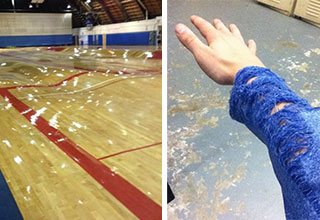18 Times Humans Looked to Nature to Create Better Technology
Andrew Cunningham
Published
Yesterday
in
ftw
The world around us can serve as the inspiration for invention.
Throughout history, humans have often looked to the natural world for innovative solutions to challenges by mimicking its designs, processes, and systems.
From the flight of birds influencing aircraft engineering to the structure of spider silk inspiring more resilient materials, nature’s intricate creations have served as blueprints for groundbreaking technological advancements.
By observing ecosystems, animals, and plant life, we've developed more efficient, sustainable, and even life-saving innovations. This ongoing relationship between nature and technology highlights the remarkable ingenuity of the natural world and its potential to shape our future.
- List View
- Player View
- Grid View
Advertisement
-
1.
 The advancement of technologies like the robotic arm, took some inspiration from the trunk of an Elephant. Boasting over 40,000 muscles within, the elephant trunk is nimble, flexible, and dexterous like a human hand / arm.
The advancement of technologies like the robotic arm, took some inspiration from the trunk of an Elephant. Boasting over 40,000 muscles within, the elephant trunk is nimble, flexible, and dexterous like a human hand / arm. -
2.
 Plants and leaves use the suns rays to harvest energy and are the basis for Solar Panels. However the effectiveness has been further improved (by 47% to be exact) by mimicking the natural folds and creases found in leaves, channeling more light into the cell.
Plants and leaves use the suns rays to harvest energy and are the basis for Solar Panels. However the effectiveness has been further improved (by 47% to be exact) by mimicking the natural folds and creases found in leaves, channeling more light into the cell. -
3.
 The modern needle was inspirited by the proboscis of mosquitoes, which make very small and clean punctures to the skin.
The modern needle was inspirited by the proboscis of mosquitoes, which make very small and clean punctures to the skin. -
4.
 Certain snakes (like Pit Vipers for example) use special sensory organs that can detect infrared radiation allowing them to "see" their prey in complete darkness. Theis was one of the inspirations for thermal imaging cameras / technology.
Certain snakes (like Pit Vipers for example) use special sensory organs that can detect infrared radiation allowing them to "see" their prey in complete darkness. Theis was one of the inspirations for thermal imaging cameras / technology. -
5.
 George de Mestral, a Swiss engineer created velcro in the 1940s after hiking and noticing the hook like features of burdock burrs that allowed them to stick to clothing and animal fur.
George de Mestral, a Swiss engineer created velcro in the 1940s after hiking and noticing the hook like features of burdock burrs that allowed them to stick to clothing and animal fur. -
6.
 A species of butterfly known as the Costa Rican Morpho Butterfly, has iridescent qualities that have been implemented to create anti-counterfeiting technology using nanoscale light-interfering structures that are much harder than a hologram to replicate.
A species of butterfly known as the Costa Rican Morpho Butterfly, has iridescent qualities that have been implemented to create anti-counterfeiting technology using nanoscale light-interfering structures that are much harder than a hologram to replicate. -
7.
 Among fish and other sea-creatures, the webbed feed of Ducks also served as inspiration for the design of flippers to help divers swim faster, deeper, and more efficiently in water.
Among fish and other sea-creatures, the webbed feed of Ducks also served as inspiration for the design of flippers to help divers swim faster, deeper, and more efficiently in water. -
8.
 Taking cues from the foot of a camel, Bridgestone is developing special tires that mimic the two-lobed toes of the Camel. The special design alows for easier movement over steep jagged hills, as well as fine grained dust or sand, or perhaps even the lunar surface.
Taking cues from the foot of a camel, Bridgestone is developing special tires that mimic the two-lobed toes of the Camel. The special design alows for easier movement over steep jagged hills, as well as fine grained dust or sand, or perhaps even the lunar surface. -
9.
 Not all animals that swim have the luxury of the fatty layers of blubber to insulate and keep them warm. Beavers for example rely on the their thick fur to trap air among the individual hairs keeping them warm and dry. A team of engineers at MIT have created wetsuits covered with small rubber 'hairs' that mimic the same qualities.
Not all animals that swim have the luxury of the fatty layers of blubber to insulate and keep them warm. Beavers for example rely on the their thick fur to trap air among the individual hairs keeping them warm and dry. A team of engineers at MIT have created wetsuits covered with small rubber 'hairs' that mimic the same qualities. -
10.
 The anatomy of a Humpback Whale's fins / flippers served as an improvement for the design of wind turbine blades. The warty ridges known as Tubercles, allow for improved air / water flow, allowing for more efficient wind turbines.
The anatomy of a Humpback Whale's fins / flippers served as an improvement for the design of wind turbine blades. The warty ridges known as Tubercles, allow for improved air / water flow, allowing for more efficient wind turbines. -
11.
 The Lotus plant is a superhydrophobic aquatic plant, which allows it to naturally repel water, dirt, and debris. Some paint and stain companies have applied this technology allowing them to create products that are 'self cleaning' in a sense, and last longer and don't get dirty as easily.
The Lotus plant is a superhydrophobic aquatic plant, which allows it to naturally repel water, dirt, and debris. Some paint and stain companies have applied this technology allowing them to create products that are 'self cleaning' in a sense, and last longer and don't get dirty as easily. -
12.
 Copying the microscopic structures on the lower abdomen of Lightning Bugs, LEDS lights with these patterns emit as much as 90% more light.
Copying the microscopic structures on the lower abdomen of Lightning Bugs, LEDS lights with these patterns emit as much as 90% more light. -
13.
 Climbing Gear - copying the millions of teeny tiny hairs on Geck toes (called 'setae'), a team at Stanford University has created better adhesive climbing gear for smooth and slippery surfaces such as glass.
Climbing Gear - copying the millions of teeny tiny hairs on Geck toes (called 'setae'), a team at Stanford University has created better adhesive climbing gear for smooth and slippery surfaces such as glass. -
14.
 Many species of animals have the ability to hide themselves using various forms of camouflage. While some creatures like chameleons can actually change the color of their bodies to blend in, basica camoflauge works by hiding the outline, shape, or contour of the body allowing it to blend in with the surroundings.
Many species of animals have the ability to hide themselves using various forms of camouflage. While some creatures like chameleons can actually change the color of their bodies to blend in, basica camoflauge works by hiding the outline, shape, or contour of the body allowing it to blend in with the surroundings. -
15.
 This may be obvious, but scientists and engineers studied various species of whales to develop the technology to create the submarine. The shape of the sub is similar to the body of the whale and the use of sonar / radar to help the sub navigate and avoid obstacles.
This may be obvious, but scientists and engineers studied various species of whales to develop the technology to create the submarine. The shape of the sub is similar to the body of the whale and the use of sonar / radar to help the sub navigate and avoid obstacles. -
16.
 Taking some notes from the majestic Albatross, drone creators have copied the shape and aerodynamic characteristics of the bird and its wings to allow for long term and low energy usage flight in drones and aircraft.
Taking some notes from the majestic Albatross, drone creators have copied the shape and aerodynamic characteristics of the bird and its wings to allow for long term and low energy usage flight in drones and aircraft. -
17.
 Architects in Zimbabwe are turning to the design of termite mounds to implement self-cooling buildings. Cooler air near the ground in channelled upward forcing the warmer air out of the building through vents and chimneys.
Architects in Zimbabwe are turning to the design of termite mounds to implement self-cooling buildings. Cooler air near the ground in channelled upward forcing the warmer air out of the building through vents and chimneys. -
18.
 Bird Safe Glass - Some companies are using the patterns of spider webs to not only re-inforce the strength of the glass, but birds can actually see the patterns and avoid the windows, unlike regular transparent glass.
Bird Safe Glass - Some companies are using the patterns of spider webs to not only re-inforce the strength of the glass, but birds can actually see the patterns and avoid the windows, unlike regular transparent glass.
- REPLAY GALLERY
-

- 18 Times Humans Looked to Nature to Create Better Technology
The advancement of technologies like the robotic arm, took some inspiration from the trunk of an Elephant. Boasting over 40,000 muscles within, the elephant trunk is nimble, flexible, and dexterous like a human hand / arm.
18/18
1/18









0 Comments